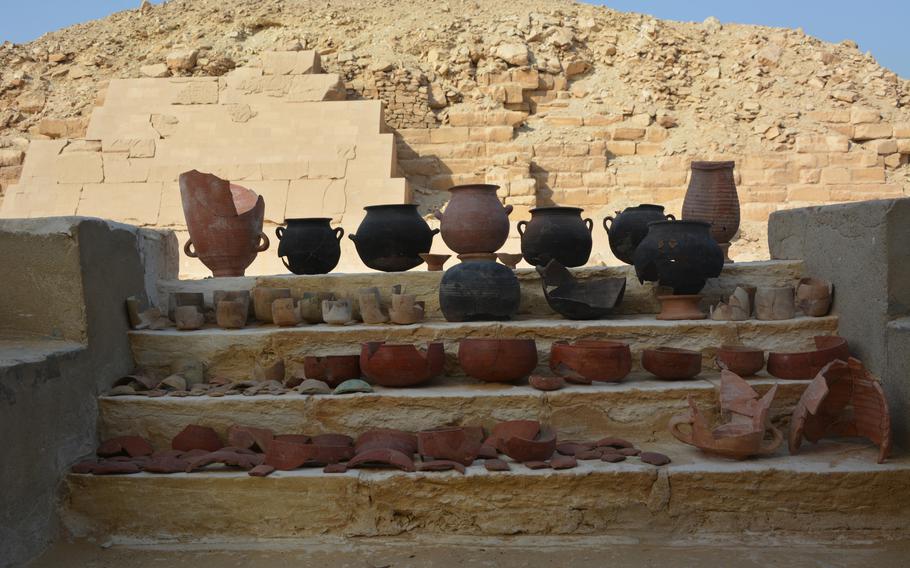
Vessels from an embalming workshop in Saqqara, Egypt, contained residues that are helping scientists unravel the mystery of how to make a mummy. (M. Abdelghaffar/Saqqara Saite Tombs Project, University of Tübingen, Tübingen, Germany)
In a 2,600-year-old embalming workshop, scientists have discovered the ingredients for making a mummy: the tars, fats, tree resins and oils ancient Egyptians used to preserve bodies and prepare them for the afterlife.
The findings, published Wednesday in the journal Nature, suggest that the substances used to make Egyptian mummies — at least at this workshop — were the product of a remarkably global supply chain, relying on trade with the Mediterranean, the rest of Africa and perhaps even Asia to source specific ingredients with antifungal and antibacterial properties.
“This is really the fascinating part of it,” said Mahmoud M. Bahgat, a biochemist at the National Research Center in Cairo and a member of the research team. “If Egyptians went that far to get these particular natural products, from these particular countries and not other countries in between, it means they meant it, it was not just done as a trial and error. ... They knew about microbiology.”
A handful of embalming manuals — along with chemical studies of select mummies — have long been the main windows into the mysterious and elaborate 70-day process of drying and preserving bodies. Then, in 2016, archaeologists unearthed an underground embalming workshop located a stone’s throw from the famous pyramids of Saqqara, the necropolis for the ancient Egyptian capital of Memphis.
The site holds more than 100 vessels, including clay beakers and red bowls, some bearing labels explaining how the contents should be used in the mummification process: “to put on his head” or “to make his odor pleasant” or to protect the liver.
With these inscribed vessels, scientists could do chemical analyses of the residues inside to try to reconstruct their original contents. The result is a highly specific window into the mummy-making process.
“What I love about archaeology is we have all these texts referring to mummification, but this one archaeological discovery gives us these huge insights you don’t get from text,” said Stuart Tyson Smith, an Egyptologist at the University of California at Santa Barbara who was not involved in the work. “The physicality of it, these materials connected with it, gives us a real rich sense of this process of preserving the body.”
The study provides a wealth of intriguing information about how ancient Egyptians were sourcing their embalming materials.
Natural bitumen, a tar-like substance, is thought to have come from the Dead Sea. Byproducts of juniper and cypress trees and resin from a flowering plant genus called Pistacia were likely sourced from the Mediterranean region. They also used resin from elemi, a tree that grows in rainforests in Africa and Asia.
Most intriguingly, the scientists found dammar resin, which comes from a family of trees that grows in forests in India and Southeast Asia.
“The industry of embalming was momentum driving forwards early globalization, because it meant you really needed to transport these resins across large distances — from southeast Asia to Egypt,” said study co-author Philipp W. Stockhammer, an archaeologist at Ludwig Maximilian University in Munich. Stockhammer believes that this occurred through a trade network that traced from what is now southern India and through the northern gulf region to Egypt.
But Smith said he was not fully convinced of the dammar result, which was found on only one sample and is the only ingredient that required a trade route to Asia. After thousands of years the residues are old and degraded, so chemical analysis can give hints about what used to be inside the vessels, but not firm readouts. That leaves room for scientific debate about whether a residue is the chemical fingerprint of a particular plant.
Smith noted, for example, that some of the chemical analyses could have been interpreted as evidence that Egyptians were importing plants found in the present-day Americas. “We know there was no cross-trade between old world and new world, so they rejected those as a hypothesis,” Smith said.
The new study challenges other long-standing assumptions about ancient Egypt. In texts, “antiu” was long thought to be a word that meant myrrh. But five vessels labeled antiu at Saqqara actually contained a mixture of animal fat and oil or tar from cedar, juniper and cypress trees. Likewise, “sefet” is thought to refer to a sacred oil, but three vessels with that label contained animal fats combined with plant additives, suggesting it could be a scented unguent instead.
Sofie Schiødt, an Egyptologist at the University of Tubingen in Germany, has studied an embalming manual from an earlier period dated to about 1450 B.C. She said that the finds will raise questions about how much the discoveries at Saqqara are specific to the site at one moment in time.
The composition of antiu, she said, is “really nothing that is anywhere close to what we would expect. The question is, why do we find this discrepancy?”
One option, she said, is that years of studies of the texts are simply wrong. But it’s also possible there is something unique about the vessels at this site, or that the ingredients used — or the word itself — evolved over time.
“This new study is really important because it gives us some new very kind of tangible evidence,” Schiødt said. “But it doesn’t really match what we would expect to find, so what does it mean?”